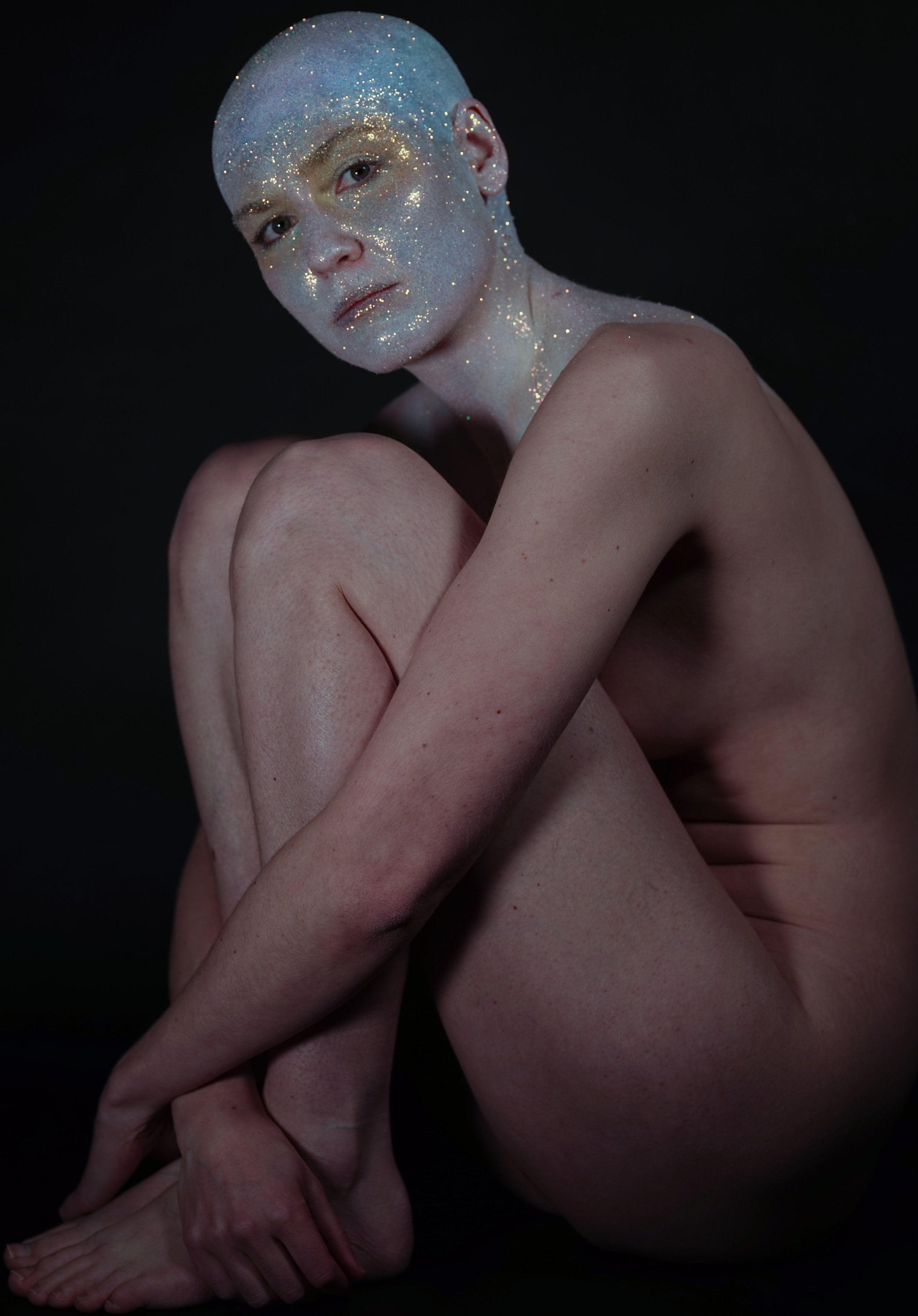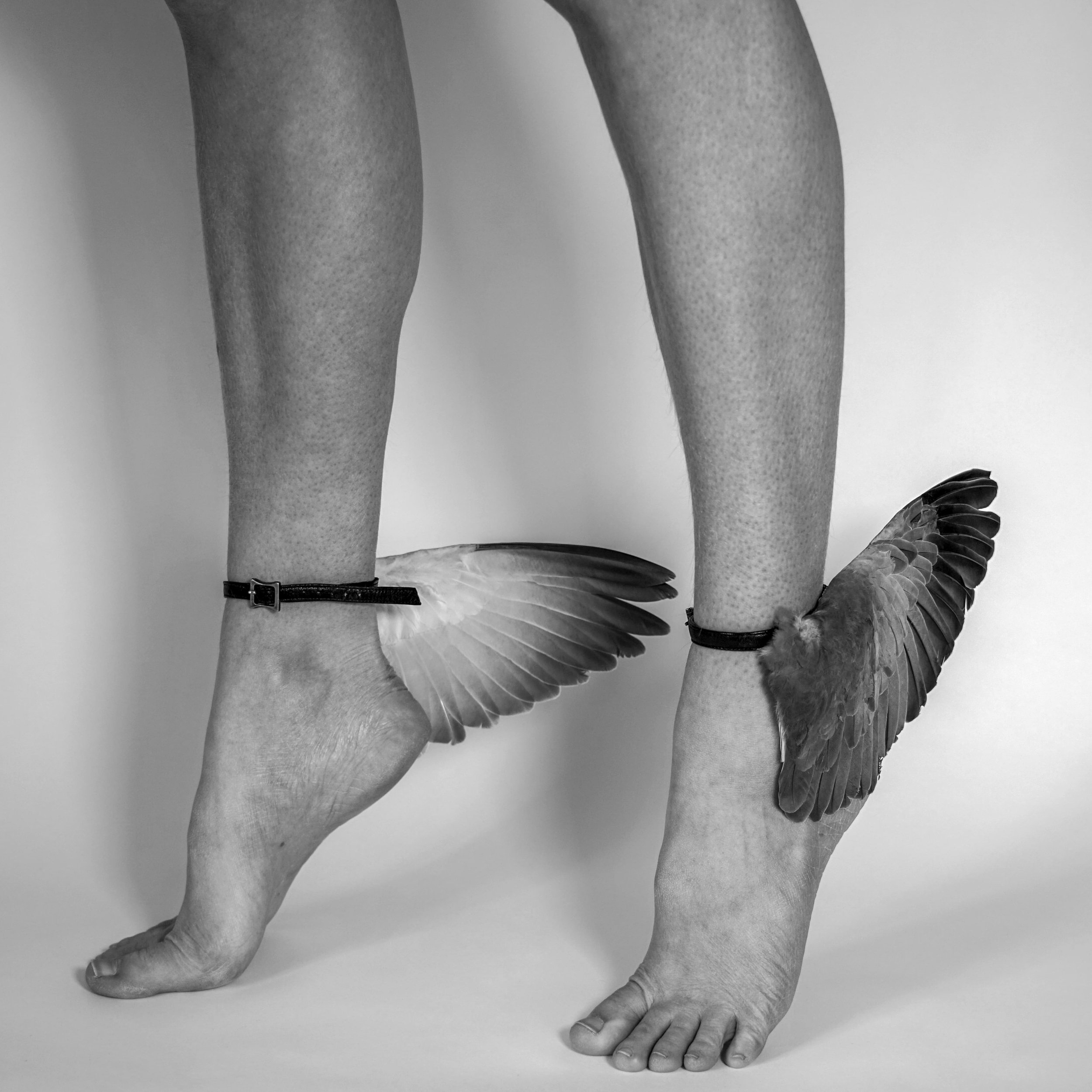Tears like opals, 2022, Collaboration with make-up artist Sim Virdi, Performance to Camera, Photo: Hollie Miller
Photo courtesy of the artist
Damaris Athene: Please could you start by telling me a bit about yourself Hollie?
Hollie Miller: I'm a performance artist with an interdisciplinary practice and a background in contemporary dance.
DA: How did you make the transition from dance to performance and visual art?
HM: My journey was through contemporary dance, ballet and Butoh, before seeking a freer way to express myself through performance art. I’m still interested in dance, but mainly somatic techniques and experiential anatomy now.
DA: What are these?
HM: They explore movement based on the imaginative sensorial body and help heighten your awareness of sensations and subtle shifts within the body. I enjoy them because they aren’t technique based dance forms and allow you to delve into the subconscious.
DA: It sounds amazing. What does your practice entail?
HM: I work with performance, film, photography, sculpture, costume and my naked body.
Blood Bone Breath, 2022, Performance to Video Camera by Hollie Miller and Hannah Buckley, Sound: Craig Scott, Costumes: Hollie Miller, Camera: Kris Abdai, Filmed at Wainsgate Dances, Supported by Arts Council England
Video courtesy of the artist
DA: What kind of themes are you exploring in your work?
HM: Recurring themes such as rebirth, metamorphosis, life and death cycles and embryology. At the moment, I'm working on a duet with dancer/ choreographer Hannah Buckley, which has a somatic focus exploring softness, rest and being in relation to another body based on healing and recovery in response to the pandemic. I also work a lot with my partner musician Craig Scott. We are currently building a new wearable musical instrument. Each project has a different focus, but they often come back to the same recurring themes of bodily lifecycles.
DA: I look forward to seeing how your wearable instrument with Craig turns out, will it make noises depending on how you move?
HM: Yeah, it resembles an external nervous system that is strapped onto my body with lots of tubing. I have conductive chords attached between my fingers and toes that turn me into a string instrument. The sound is activated by my movement. I'm connected to Craig’s sound sources through an umbilical cord. This instrument could have been wireless, but Craig works a lot with analog hardware and we've been really thinking about how bodily these wires are and how they can become an extension of my body’s nervous system.
DA: That sounds really interesting. Do you have any performances coming up?
HM: We have an upcoming residency at V SS L in Deptford and are performing there on the 18th August.
To Melt/ To Crystallize, 2019, Performance to Camera, Video Still: Hollie Miller
Made during a residency at the Serlachius Museum, Finland
Image courtesy of the artist
DA: What motivates you to work with performance and time based media?
HM: It's just how I express myself. When I was younger, I was very shy but I loved dancing and gymnastics. I always had a bodily confidence that I didn't have in speech. I'd make really elaborate dance routines in the living room and perform them at school concerts and it just grew from there.
DA: How interesting that your initial form of communication was with your body. Could you speak more about how you use your body in your practice?
HM: My body is my primary material, it is a raw and evolving piece of flesh. It is always there for me - it is very loyal. It fascinates yet frustrates me and I return to it over and over again. I try to work through these blockages. I find restrictions can be creatively helpful to push against.
DA: Has using your body in your practice changed your relationship with it?
HM: It’s helped me to connect more deeply with in search of a spiritual and philosophical meaning behind what it means to be embodied in a physical form.
DA: Do you train your body in certain ways to be able to do the work?
HM: I do yoga and dance improv classes. If I am preparing for an endurance based performance I’ll do some extra training to get my fitness up. In my performance 'Animus' I performed in a pool of slime for a long duration. I ended up injuring my knee. While I explore the limits of the body it was a reminder that it is my main material and I need to look after it. I have since thought more about ways to incorporate care and sustainability into my practice.
ANIMUS, 2020, Durational Performance and Sound Art Installation in collaboration with Craig Scott
Video courtesy of the artist
DA: Do you show a lot of video work as well so you don't always have to be there and be present?
HM: Yeah, I love making films and taking photographs, but with that you just send an mp4 file or a print off to a gallery and I don't really get a kick out of it like I do with performing. Performing is an adrenaline thing, you get high off the liveness and intimacy with strangers. It's all about the audience’s presence and how they influence the moment. That's the magic part.
DA: Could you expand on how you use sound in your work?
HM: Craig is a musician, sound artist, composer and decomposer! He builds sound sculptures out of electronic detritus. He creates the musical scores for my films and we perform together live. We did a piece called ‘Sonic Archetypes’ where he made a feedback mobile from a group of speakers that spin on a stick around directional microphones. We’re now trying to take our collaborative work a step further by building this new wearable instrument so that the sound and movement making is simultaneous.
Sonic Archetypes, 2020, Collaboration between performance artist Hollie Miller and sound artist Craig Scott, Performed at San Mei Gallery, London, Camera: Sam Williams
Video courtesy of the artist
DA: Your performances and the sound alongside are really powerful. Animals and nature often feature in your work and sometimes sort of human-animal hybrids. For me, nature feels like a sinister force, and I was wondering whether you could expand upon that.
HM: There is a darkness to my work regarding the nature/ culture battle. When I perform naked I am trying to strip my body of culture but that’s impossible because culture is so embedded in us. I’ll often cover myself in organic matter eg. mud in an attempt to erase my identity and ego. Eventually we die and nature consumes us and lives on. It is an overpowering force, we are just ants! That’s why I like performing outdoors in the landscape. It puts the body into perspective.
DA: That's really interesting how you’re trying to strip your identity away. A lot of it is so uncanny with the costume and in the movement, and it’s very unsettling. We're not used to seeing humans like that. It's almost like you're being taken over by nature and the sound adds a lot of tension to the work. How do you usually work? Do you find that that's been affected by the pandemic?
HM: As a live performer it was very difficult. All of my gigs disappeared and that was the bit I love most. Like many other performance artists I did more lens-based work.
DA: What would you like people to get from your work?
HM: Some of my work can be a bit uncomfortable and I think especially now, because of the pandemic, there's more anxiety over the body and intimacy. In my work where I am naked, I am thinking about the agency of my displayed female body and the audience’s gaze and playing with the malleability of this power play- this emotional elasticity and psychology interests me greatly. I aim to intrigue or provoke. I'm not trying to shock, but subtly get under people’s skin!
Disgust/ Lust, 2015, Performance to Camera, Photo: Genevieve Lutkin
Photo courtesy of the artist
DA: Yeah, I think that can be a lot more powerful than something that's really in your face. Have you had any surprising or memorable reactions?
HM: One time in a performance a woman screamed and threw her handbag at me and ran out!
DA: *laughs* How do you find it when you're performing with your naked body?
HM: When I first started doing it, it was really raw and vulnerable and I wasn't really sure what I was doing. Now I often have Craig supporting me with his sound. Often in gallery spaces the audience is everywhere as there’s no front or back like on a stage so Craig’s sound casts a protective space around me, it gives me energy and power that I didn’t have before.
DA: Whose work inspires you?
HM: Doris Uhlich, Keira O'Reilly, Regina José Galindo, Rocio Boliver, Iiu Susiraja to name a few!
DA: What ideas do you have bubbling away?
HM: I’m currently obsessing over Leda and the Swan. I’d really love to make a new piece about that.
DA: Good luck! Thank you so much Hollie, it’s been great talking about your practice.
HM: Thank you!
Spikes and Ladders, 2021, Documentation of live performance collaboration with Craig Scott at UK Mexican Arts Society, London, Performance: Hollie Miller, Sound: Craig Scott, Camera: Sam Williams
Video courtesy of the artist



